Pluto with a super-cryovolcano? Why not! All the elements are there, just not in the way we normally think of volcanoes. And, cryovolcanoes are the reason why Pluto’s surface looks the way it does. A recent research paper explains why Pluto could be the home of the latest supervolcano discovery in the Solar System.
Planetary scientist Dale Cruikshank and a group of colleagues have been studying a strange feature on Pluto called Kiladze Crater. Its existence raises a lot of questions about what’s happening inside Pluto to create this weird landscape. The researchers recently released a paper exploring this region and offering an explanation for its appearance.
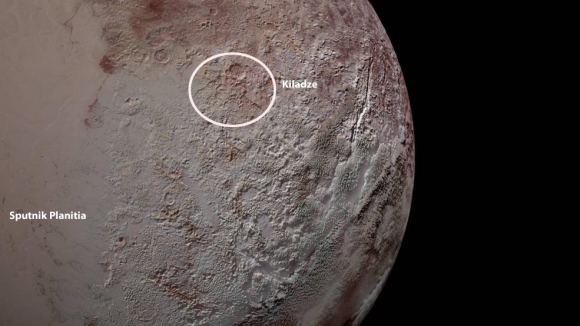 Kiladze (circled) is likely a super cryovolcano on Pluto. It contains fault structures and collapse pits that formed through cryovolcanism. The crater (or caldara) shape looks distorted, likely from internal stresses and tectonic shifting. Courtesy New Horizons mission (labeled by author).
Kiladze (circled) is likely a super cryovolcano on Pluto. It contains fault structures and collapse pits that formed through cryovolcanism. The crater (or caldara) shape looks distorted, likely from internal stresses and tectonic shifting. Courtesy New Horizons mission (labeled by author).
The team suggests strongly that Kiladze is a super cryovolcano. Cryovolcanism is the process that sends ice “lava” to the surface of Pluto. We’ve seen it across the outer solar system, in some of the moons of Jupiter, Saturn, Uranus, and Neptune. Like its “sister” form of volcanism here on Earth, some kind of heating melts mantle materials, which can eventually escape to the surface. We’re used to seeing rocky lavas. However, ice and water act as “lava”, too, if conditions are just right.
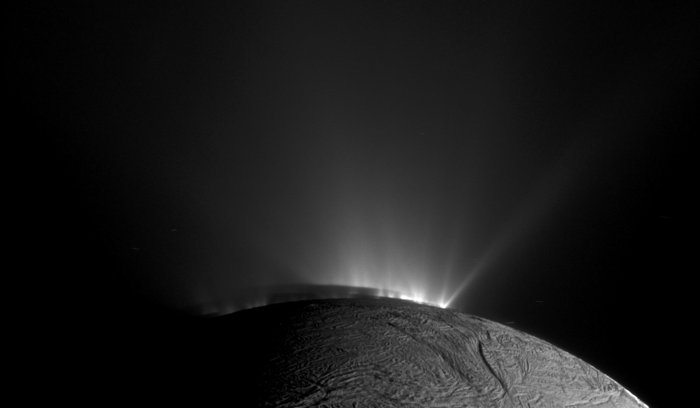 Cryvolcanism at Enceladus, a moon of Saturn. This Cassini narrow-angle camera image looks across the south pole of Enceladus and its geysers of material. Credit: NASA/JPL-Caltech/Space Science Institute
Cryvolcanism at Enceladus, a moon of Saturn. This Cassini narrow-angle camera image looks across the south pole of Enceladus and its geysers of material. Credit: NASA/JPL-Caltech/Space Science Institute
And, that’s where Pluto comes in because the conditions are ripe for cryovolcanism. During the New Horizons Pluto flyby in 2015, several features drew the attention of scientists as possible cryovolcanic regions. That included a region called Virgil Fossae. It lies to one side of Sputnik Planitia, a prominent heart-shaped surface feature on Pluto. Kiladze lies at the top of the right “lobe” of the heart and its appearance really had Cruikshank and his colleagues debating its cause.
New Horizons acquired both images and spectroscopy of Pluto during its flyby in 2015. One thing that became immediately evident about Kiladze is that there’s water ice scattered around it. That’s unusual because methane and nitrogen ice cover most of the surface of Pluto. So, a patch of water ice surrounding a strange-looking feature seemed unusual. Not only that, but the ice contained an ammonia compound. Some kind of activity brought the water-ammonia mixture up from deep below the surface. But what?
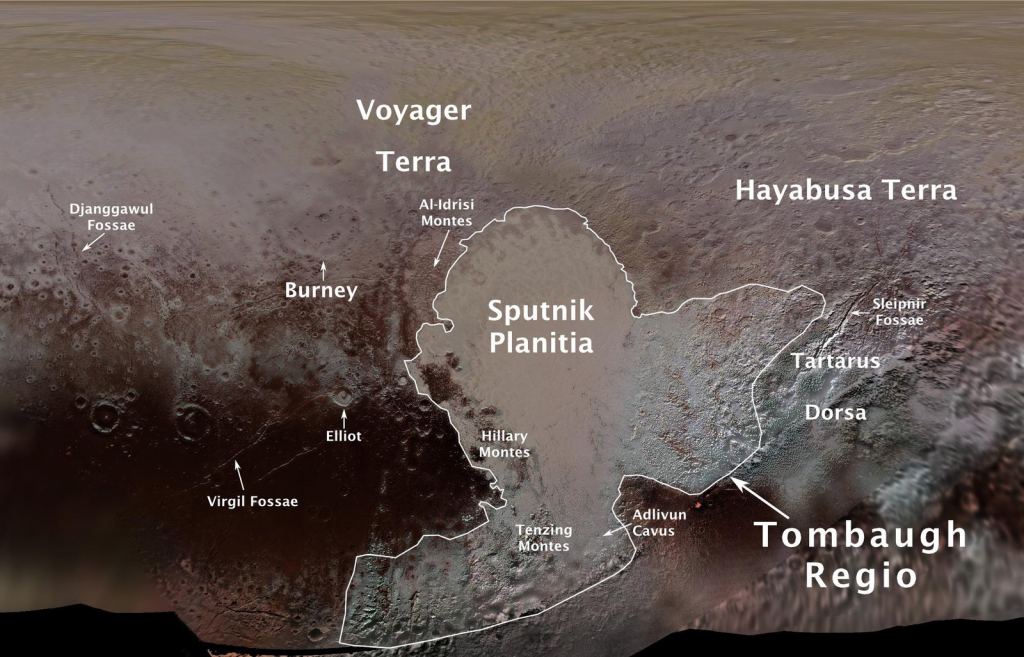 A labeled map of Pluto’s surface features, including the Virgil Fossae region (another cryovolcanic region) on the planet. Kiladze lies just off the right “lobe” of Sputnik Planitia and to the left of Sleipnir Fossae in this map. Courtesy New Horizons/NASA.
A labeled map of Pluto’s surface features, including the Virgil Fossae region (another cryovolcanic region) on the planet. Kiladze lies just off the right “lobe” of Sputnik Planitia and to the left of Sleipnir Fossae in this map. Courtesy New Horizons/NASA.
According to Cruikshank, heating is the culprit. “For Pluto, internal heat is also expected to be the driver for volcanism seen in some places at the surface, but we don’t know if there is a subsurface global ocean of water plus various chemicals, or simply pockets of water plus chemicals left over from the time Pluto formed and had a hot interior,” he said. “This is a mystery for the next generation of planetary scientists to solve.”
Beyond volcanism, Cruikshank and his team considered the possibility that Kiladze is some kind of distorted impact crater. So, they also examined the surface feature for signs of some alternate origin. Aside from the surface materials, the morphology of the region shows evidence of tectonic activity. There are faulted structures and collapse pits and its overall crater shape is distorted. That doesn’t necessarily point to an impact origin, so what happened at Kiladze? The answer lies in Pluto’s interior structure.
Pluto is an icy body wrapped around a rocky core. Much of the “bedrock” of the planet is water ice. A “contaminant” of tholins covers the methane and nitrogen surface ice. Tholins are hydrocarbon compounds created as the gases in the atmosphere and ice on the surface are bombarded by cosmic rays and other radiation. The big job for planetary scientists is to look at all the different surface units on Pluto and figure how how they formed. Cryovolcanism is certainly an important part of that surface “calculus”.
Cryovolcanism happens at Pluto because something is heating the interior and sending water ice to the surface. The radioactive decay of elements inside the core is the most obvious explanation for the heating. If so, it might create an ocean of liquid water or pockets of slushy water ice. Some scientists suggest that water ice (or icy slush) surrounds the core.
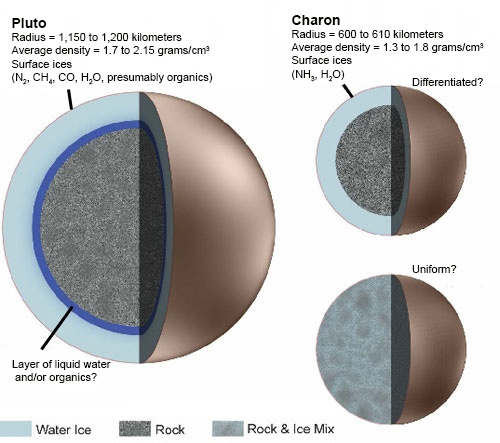 This is a general model of what Pluto’s interior may be like. Courtesy New Horizons mission.
This is a general model of what Pluto’s interior may be like. Courtesy New Horizons mission.
Interestingly, there are places on the surface with patches of water ice, mixed with ammonia. That mixture appears to come from the planet’s interior. Interestingly, ammonia lowers the freezing point of water, which allows it to flow as an icy “magma” through Plutonian cryovolcanoes. Cruikshank pointed out that ammonia it could also be in the form of ammoniated salt or hydrate. It’s not completely clear where it originated. He suggests that it was part of the original mix of material from which Pluto (and most other bodies in the Solar System) condensed some 4.5 billion years ago.
Pluto isn’t the only place where ammonia exists, just the most distant (so far). “We’re finding evidence of some kind of ammonia in the spectra of numerous transneptunian objects obtained with the Webb space telescope (not yet published), and it is apparently a ubiquitous component of the planets and small bodies,” he wrote in an email. “It is also a critically important component of prebiotic molecules, as shown in lab studies in which amino acid precursors are synthesized.”
The Kiladze structure is about 44 kilometers across and lies in a sub-region called Hayabusa Terra on Pluto. In the team paper, it’s described as “a super cryovolcano with a resurgent caldera, having a history of one or more eruptions ejecting a thousand kilometers of cryo-lava and possibly an unknown number of eruptions of smaller scale.”
In their paper, Cruikshank’s team discusses the possible causes of Kiladze, including that it stemmed from some ancient impact. However, the presence of fresh ice and the lack of a thick layer of tholins are some of the clues that point more to cryovolcanism both in that region and in Virgil Fossae.
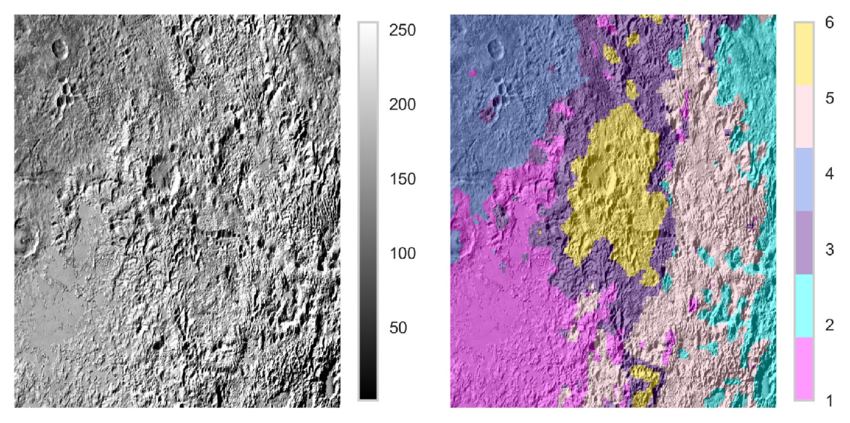 A high-resolution image of the Kiladze Crater region on Pluto (left) and a map of the spatial distribution of those surface units. Courtesy Al Emran, NASA/JPL.
A high-resolution image of the Kiladze Crater region on Pluto (left) and a map of the spatial distribution of those surface units. Courtesy Al Emran, NASA/JPL.
It’s pretty likely that Kiladze is relatively young. It’s certainly not as old as the rest of the surface. The team suggests that its eruptive activity took place over the past few million years. The clues lie in the surface coverings. If Kiladze were old, you’d expect to see some kind of built-up surface layer over the most obvious features. This would be true if a constant rain of organic dust particles from the atmosphere had been settling down over the age of the planet. “We have a good idea of the formation and settling time for smog particles on Pluto,” he pointed out, “and if the Kiladze structure had been sitting there for billions of years, the smog particles would obscure the water ice spectral signature detected by the New Horizons spacecraft in 2015. Hence, the conclusion that it is relatively recently formed.”
By “recently”, the team thinks that the exposed patches of water ice may only be a few million years old. And, they may not just be from one large eruption. This super cryovolcano on Pluto has likely erupted many times since it formed. Its very presence—along with recent studies of volcanism at Virgil Fossae—gives future researchers some very important clues as they seek to understand this world’s interior structure.
Kiladze Caldera: A Possible “Supervolcano” on Pluto
Recent Cryovolcanism in Virgil Fossae on Pluto

